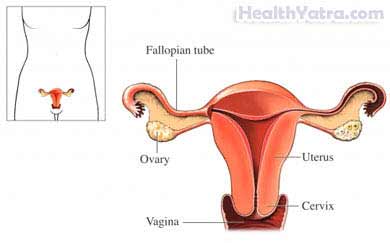Definition
Hysterosalpingography is a type of x-ray exam. It is used to examine the uterus (womb) and fallopian tubes. A contrast (dye) is injected into the uterus. It helps to create clearer images.

Reasons for Test
Hysterosalpingography is used to evaluate:
- Infertility
- Abnormal bleeding
- Abnormal pubertal development
- Traumatic injury
- The presence of foreign objects
Possible Complications
All x-rays expose you to a certain level of radiation. These levels are considered safe for most but are not recommended for pregnant women. Tell your doctor if you are pregnant.
Some people may also have an allergic reaction to contrast used to enhance the image. Let your doctor know about any allergies you may have.
What to Expect
Prior to Test
Your doctor will ask you about your medical history. If you have had pelvic inflammatory disease in the past, it is important that you share this information with your doctor.
In the days leading up to the test:
- Schedule the test within the first 10 days after your period starts. This timing will decrease the chance of disturbing an unknown pregnancy.
- Your doctor may ask you to:
- Take pain medicine or antibiotics.
- Take a laxative or enema.
- Have a light meal the night before. Do not eat or drink anything after midnight, unless told otherwise by your doctor.
- Plan to wear comfortable clothes.
- Arrange for a ride to and from the test.
Description of Test
You will lie on a special x-ray table. Your feet will be in foot rests or pulled up to your chest. The doctor will do a pelvic exam to check the position of the uterus and check for tenderness or inflammation. A device called a speculum will be inserted to gently open the vagina. A catheter (tube) will be inserted through the cervix and into the uterus.
You will be repositioned after the tube is inserted. The contrast material will be slowly injected through tubing connected to the catheter into the uterus and fallopian tubes. The x-ray machine will create images that the doctor can see. X-ray photos will also be taken during the test. The table may be tilted or you may be asked to roll from side to side for better views or pictures. When x-rays of all the areas have been taken, the instruments will be removed.
After Test
You will be observed for about 30 minutes after the test. The staff will look for signs of an allergic reaction and bleeding. You will then be able to leave.
After the test, be sure to follow your doctor’s instructions . In general:
- Expect some bleeding for a few days after the test.
- Use over-the-counter pain medicine to relieve discomfort as needed.
- An antibiotic may be ordered to prevent infection. Take all of the pills that are given.
- Do not stop the medicine, unless told otherwise by your doctor.
- Do not use tampons or engage in sexual intercourse for 48 hours after the procedure.
- Baths and showers are OK.
How Long Will It Take?
About 15-45 minutes
Will It Hurt?
Most patients report some discomfort and cramping during this test. If there is a blockage, it may cause more intense pain. Your doctor may order pain or sedating medicines. The medicines are often taken one hour before the test.
Results
A radiologist interprets the x-ray films and reports what was found to the doctor who ordered the exam. Your doctor will then make recommendations for treatment.
Call Your Doctor
After you leave the hospital, call your doctor if any of the following occurs:
- Increased pain
- Heavy vaginal bleeding
- Signs of infection, including fever and chills
- Abdominal pain
- Nausea or vomiting
- Itching, hives, or rash
- Difficulty breathing and/or swallowing
